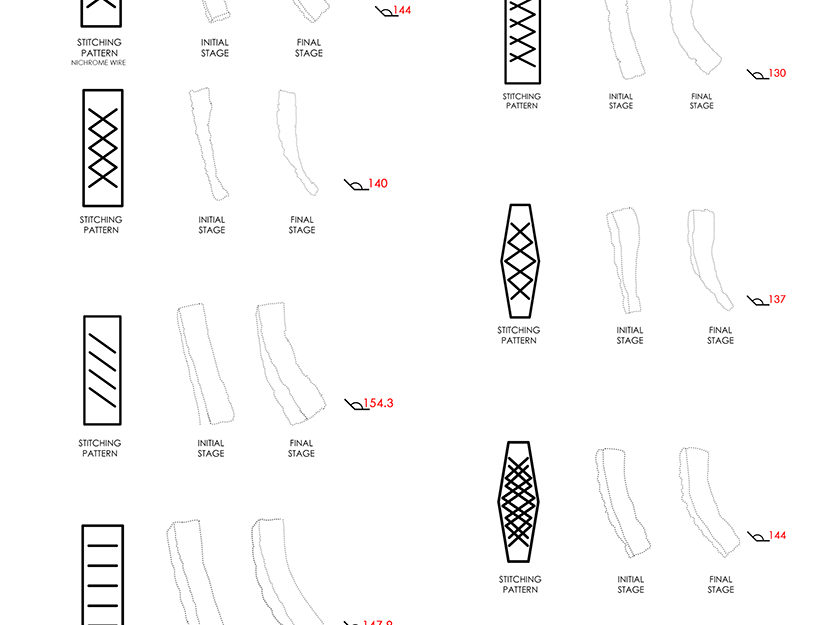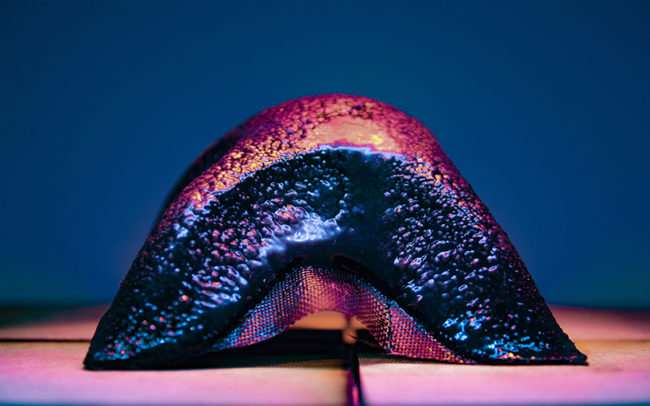How can a soft and passive material system change the rigidity of built habitats and functions?
Soar is a material system that looks for an alternative to rigidity. It is derived from soft robots that are generally actuated with pneumatics or liquids. SoAr works with a liquid that evaporates at low temperatures, and an elastic polymer that traps this liquid in the form of bubbles. In this research, these materials are alcohol and silicon. The ingredients of this system allow it to respond to the heat of the sun thus making it passive.
It doesn’t need any additional energy and it is never constant. The wind, the angle of the sun and the moisture all play a role in how the actuators will react so it is safe to say that no two actuators will behave identically, giving it the illusion of being alive. This research concentrates on how these softbots could be controlled, what properties they possess and what could be their future use.
This project is the continuation of an Iaac student project, Pneu.Flex. The initial material system with silicon and alcohol was developed in Pneu.Flex.
The system works with heat, and the objective of this research was to activate it with the heat from the sun and to test the boundaries as well as potentials of this system. The experiments were conducted using an Infrared lamp to substitute for the sun.
 |
The improved material system is made of the silicon-alcohol mix and a glass fiber mesh. |
Specific Heat
The specific heat is the amount of energy (joules) needed to raise 1 gr of matter by 1 degree Celcius.
The diagram of the initial material system showing the alcohol bubbles. This system is activated with heat.
Experiment 01
The first set of experiments in our methodological approach consists of the following Ingredients:
– Ecoflex Silicon
– Ethanol (96%)
– Additive X
– Glass Fibre Mesh
An activated two-legged softbot.
Making of a softbot:
– Silicon Part A is mixed with alcohol and Silicon Part B is mixed with the Additive X.
– These two parts are then combined and cast into the mold.
– This whole system is placed over the glass fiber mesh.
– A layer of silicon is brushed over the top and bottom. This is done to restrict the escaping of alcohol from the material system
A material test that aims to raise the thermal conductivity. The first sample is mixed by hand and the second one is mixed with a mixer. The rest contain either iron or black ink or graphene.
Additive X
Experimented with 5 different additives along with alcohol to decrease the specific heat of the whole material system. Graphene with its very low specific heat value and high thermal conductivity decreases the specific heat value of the whole material system. So, the soft robot with graphene works better than the other tests.
Experiment 02
The base material system being set from the previous set of tests, the next step was to improve on the geometry of the softbots. The geometry of the softbots where modified so that they hold more volume of alcohol in them, which aids in inflation. The new geometry showed better results than the old softbot geometry. The inflation achieved was double with relatively less temperature but more time.
An activated two-legged softbot. A geometry test comparing different bump sizes.
Experiment 03
The objective of these tests was to understand the strength and the potentials of the softbot by embedding it on an aluminum mesh as well as a glass fiber mesh. Comparing the results it is evident that the softbot is not powerful enough to bend aluminum mesh.
Experiment 04
The aim of the experiment is to reduce the time of fabrication and complexity whilst achieving various bending actions. These set of experiments include incorporating a stitching pattern on to a softbot. This method involves having a base prototype made of the following ingredients, silicon, graphene, alcohol, and mesh on which the stitching pattern will follow. Different patterns were tested to achieve various bending actions.
A catalog of stitching patterns and their stages. Including their deformation angle. An activated stitched softbot.
Experiment 05
These tests were the beginning stage of the scaling-up process. We decided to go with a simple 80×80 mm rectangle which then we stitched in various patterns. These tests included prototypes of 1.5 and 2cm thickness. The stitches control the direction of the forces successfully yet if a needle penetrates the softbot surface a great deal of alcohol is lost resulting in an unsatisfactory activation. Plus any restriction to the softbot results in less movement. Lastly, the amount of material used on these tests was excessive therefore there was a need for an improvement in that part.
An activated softbot in the cooling stages. An activated softbot in its maximum height. The mesh provides a substructure and directs the forces to aid in the bending action.
Experiment 06
After the success of the last tests, half of the material was removed while keeping the skeletal system of the prototypes. These prototypes were lighter and as strong as the previous ones resulting in decent activation. The most optimized prototype from these tests was a prototype with 1.5cm thickness and 7 cm leg length.
Experiment 07
In these set of tests, the main objective was to scale the components up. This mainly resulted in failure. The first iteration was a component of 4cm thickness and 8.5 cm leg length. The second iteration was a component of 2cm thickness and 10cm leg length.
Experiment 08
The last working prototypes were consisting of two-legged, three-legged and four-legged softbots. These geometries allowed for a gradient of movements.
Prototypes of the first eight experiments.
Initially thought to be applied to a structure as a facade, each geometry controls the solar radiation and the ventilation differently. The two-legged component provides bigger but fewer openings. The four-legged one provides many openings yet they are very small.
These parameters with the help of an evolutionary solver algorithm, allow for a design from environmental conditions such as the sun path, prevailing wind, etc. Referencing the emergence occurring in nature. A unique structure that performs differently than the sum of its parts.
A render of a soft architecture. Responsive and self-sufficient.















